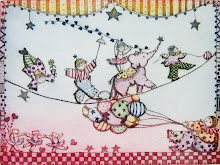
The art of etching has been practiced for more than five hundred years, but it was the Dutch masters, Rembrandt among them, who refined it into its present form in the 17th century.
An etching is produced on a metal plate which has been etched by acid. This plate may be copper, zinc, steel or other metals. After careful cleaning, the plate is prepared by applying a special "ground", an acid resistant coating.
The artist draws her lines into this "ground", with a light point or needle. The plate is then immersed in an acid solution, which bites into the metal where the artist has drawn. The ground protects the rest of the plate from the action of the acid, leaving the artist's creation etched into the metal.
The artist then works ink into the plate. The inks sink into the etched lines and areas of the plate. The artist wipes away any excess ink on the relief surfaces.
Paper is then placed on the inked plate, and the two together are pulled through the rollers of a hand-operated printing press, which prints the image on the paper by pressure.
Etching papers and inks vary widely in quality and feeling. Those of good quality will last for a long, long time. There are many other processes besides the "intaglio" method described here.
The artist then cleans the plate and prepares to go through the inking process again, to produce the next plate, so each etching is an original piece of hand produced art.
The etching plate has a limited lifetime, as the quality of the lines deteriorates under the pressure of the hand press. The artist must know approximately the number of prints that can be made. This is why each original etching is numbered as part of a series.
Your etching will thus be numbered "3/50" for example. This means it is the third in a series of fifty. So you know that your original etching is one of only fifty that exist in the world.
You may also see the designation "A/P". This means "Artist's Proof". Such an etching may be one of a kind, or it may be one of a few extra etchings, never more than ten percent, which the artist has not included in the numbered series. There may also be "working proofs" which the artist makes at various stages of creating the final work.
An etching is produced on a metal plate which has been etched by acid. This plate may be copper, zinc, steel or other metals. After careful cleaning, the plate is prepared by applying a special "ground", an acid resistant coating.
The artist draws her lines into this "ground", with a light point or needle. The plate is then immersed in an acid solution, which bites into the metal where the artist has drawn. The ground protects the rest of the plate from the action of the acid, leaving the artist's creation etched into the metal.
The artist then works ink into the plate. The inks sink into the etched lines and areas of the plate. The artist wipes away any excess ink on the relief surfaces.
Paper is then placed on the inked plate, and the two together are pulled through the rollers of a hand-operated printing press, which prints the image on the paper by pressure.
Etching papers and inks vary widely in quality and feeling. Those of good quality will last for a long, long time. There are many other processes besides the "intaglio" method described here.
The artist then cleans the plate and prepares to go through the inking process again, to produce the next plate, so each etching is an original piece of hand produced art.
The etching plate has a limited lifetime, as the quality of the lines deteriorates under the pressure of the hand press. The artist must know approximately the number of prints that can be made. This is why each original etching is numbered as part of a series.
Your etching will thus be numbered "3/50" for example. This means it is the third in a series of fifty. So you know that your original etching is one of only fifty that exist in the world.
You may also see the designation "A/P". This means "Artist's Proof". Such an etching may be one of a kind, or it may be one of a few extra etchings, never more than ten percent, which the artist has not included in the numbered series. There may also be "working proofs" which the artist makes at various stages of creating the final work.


1 comment:
Looks great Margaret and Mary! I wish you'd bring your works back to Chicago :) I am happy to be one of your most proud, private collection owners.
XO Lesli
Post a Comment